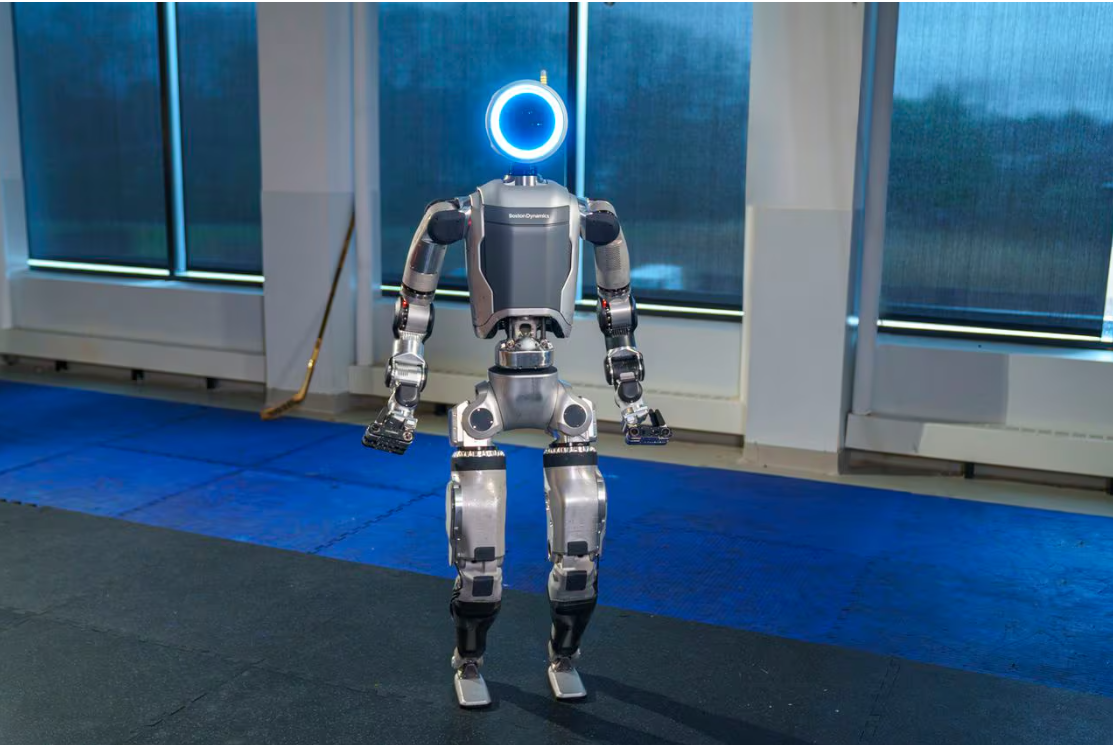波士顿动力公司的跳舞机器人 Atlas 终于上市了

【中美创新时报2024 年 4 月 18 日编译讯】(记者温友平编译)位于沃尔瑟姆(Waltham)的波士顿动力公司推出了其 Atlas 机器人的电动版本,该机器人将出售给制造业,用于在工厂工作。该公司此前只用Atlas做过实验和制作YouTube视频。对此,《波士顿环球报》记者亚伦·普雷斯曼(Aaron Pressman)作了下述报道。
沃尔瑟姆机器人先驱波士顿动力公司正在进入日益拥挤的人形机器人市场。
多年来,该公司不断发布其人形机器人 Atlas 的狂野视频,展示其表演舞蹈、后空翻以及主演超级碗广告等特技。但该公司所称的液压驱动“研究平台”从未打算出售。
直到现在,周三,波士顿动力公司宣布它已经创建了 Atlas 的商业版本,最终将出售给制造业。
该公司表示,新的 Atlas 是电动的,能够举起重物,其力量超过了人类精英运动员。该机器人还可以扭转身体并以人类无法做到的方式移动,例如向后弯曲膝盖和将躯干旋转 360 度。
这一消息发布之际,人们对仿人机器人的兴趣和投资已经开始兴起。自从埃隆·马斯克推出特斯拉的 Optimus 机器人以来不到两年,俄勒冈州 Agility Robotics 和加利福尼亚州 Figure AI 领导的初创公司已筹集了数十亿美元。十月份,亚马逊表示将尝试在其仓库中使用 Agility 的机器人。
波士顿动力公司首席执行官罗伯特·普莱特 (Robert Playter) 在接受采访时表示:“我们希望拥有一台机器,当我们宣布这一消息时,它能向世界宣告,波士顿动力公司再次为类人机器人树立了标杆。”他说,新的 Atlas 机器人可以在工厂里搬运重型和奇形怪状的物品,但并不是为了在仓库里搬运箱子。
普莱特说:“这实际上是工厂内将零件转移到装配线的物流。”他指出,许多零件的形状或重量使得典型的工厂机器人难以处理。“我真的不认为这是盒子。如果你要捡起盒子或垃圾箱,你应该建造另一个机器人。”
普莱特于 2019 年接替创始人、前麻省理工学院教授马克·雷伯特(Marc Raibert)担任首席执行官,他表示,波士顿动力公司开发 Atlas 商业版已经有一段时间了,但在接近完成之前不想公开发布。他拒绝透露该机器人的成本是多少。
首先,波士顿动力公司的所有者现代汽车将于明年在其工厂测试该机器人。普莱特表示,如果事情按计划进行,在未来几年中,Atlas 将扩展到制造业的一小部分客户。
Atlas 将是波士顿动力公司 32 年历史上的第三款大型商用机器人。该公司于 2019 年开始销售其狗形机器人 Spot。而能够从卡车上卸下箱子的 Stretch 则于 2022 年上市。
所有的机器人,包括新版本的 Atlas,都使用机器学习和人工智能技术来帮助导航它们的环境。该公司去年开始在软件中使用 ChatGPT 来控制其 Spot 机器人。
普莱特表示 Atlas 将需要能够处理数百甚至数千个不同的任务。 “人工智能软件对于实现这种程度的通用性至关重要,”他说。
题图:位于沃尔瑟姆的波士顿动力公司推出了其 Atlas 机器人的电动版本,该机器人将出售给制造业,用于在工厂工作。由 BOSTON DYNAMICS 提供
附原英文报道:
Atlas, Boston Dynamics’ dancing robot, will finally be for sale
The Waltham company had previously only done experiments and made YouTube videos with Atlas
By Aaron Pressman Globe Staff,Updated April 17, 2024
Waltham robotics pioneer Boston Dynamics is entering the increasingly crowded market for humanoid robots.
For years, the company has released wild videos of its human-shaped robot, Atlas, performing tricks such as dancing, doing back flips, and starring in a Super Bowl commercial. But the hydraulic-powered “research platform,” as the company called it, was never intended for sale.
Until now. On Wednesday, Boston Dynamics announced it has created a commercial version of Atlas that will be be sold — eventually — to the manufacturing industry.
The new Atlas is electric-powered and able to lift heavy items with strength exceeding an elite human athlete, the company said. The robot can also twist its body and move in ways that a human cannot, such as bending its knees backwards and spinning its torso 360 degrees.
The announcement comes as interest and investment in humanoid robots has taken off. In less than two years since Elon Musk unveiled Tesla’s Optimus robot, startups led by Agility Robotics in Oregon and Figure AI in California have raised billions of dollars. And, in October, Amazon said it would try using Agility’s robots in its warehouses.
“We wanted to have a machine that, when we did announce, said to the world that Boston Dynamics just set the bar for humanoids again,” Robert Playter, chief executive at Boston Dynamics, said in an interview. The new Atlas robot could move heavy and odd-shaped items around in a factory, but isn’t aimed at moving boxes in warehouses, he said.
“It’s really the logistics within factories of moving the part to the assembly line,” Playter said, noting that many parts have a shape or weight that it makes it difficult for typical factory robots to handle. “I don’t really think it’s boxes. If you’re going to pick up boxes or bins, there’s another robot you should go build.”
Boston Dynamics has been working on the commercial version of Atlas for a while but did not want to unveil it publicly until it was close to finished, said Playter, who took over from founder and former MIT professor Marc Raibert as CEO in 2019. He declined to reveal how much the robot would cost.
At first, Boston Dynamics owner Hyundai will test the robot in its factories next year. Then, if things go according to plan, over the next few years, Atlas will expand to a small set of customers in the manufacturing sector, Playter said.
Atlas would be Boston Dynamics’ third wide-scale commercial robot in its 32-year history. The company started selling its dog-like robot Spot in 2019. And Stretch, which can unload boxes from a truck, hit the market in 2022.
All of the robots, including the new version of Atlas, use machine learning and artificial intelligence technology to help navigate their environments. The company last year started using ChatGPT in software to control its Spot robot.
Playter said Atlas will need to be able to handle hundreds or even thousands of different tasks. “AI software is going to be essential for enabling that level of generality,” he said.

